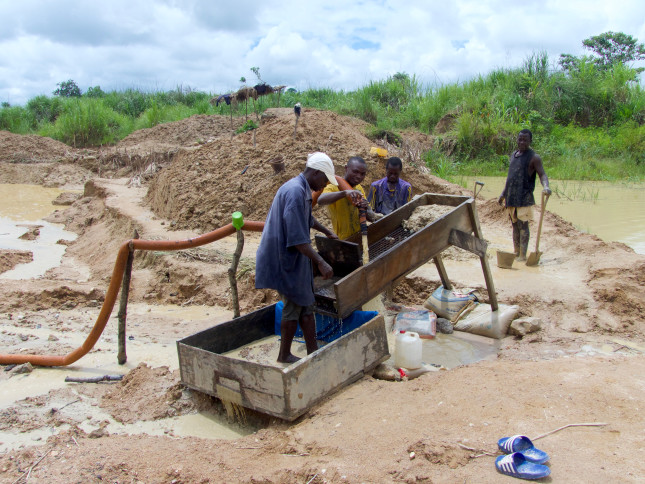-
Can COP26 Meet the Climate and Conflict Challenge?
November 2, 2021 By Jessica Hartog
Global climate action must be sensitive to ‘land grabs’ and lost livelihoods for both a safer and greener world to be built in Glasgow.
With all eyes on COP26, the world is holding its breath. This year’s negotiations will need to see truly ambitious commitments to ramp up climate action in order to avoid a dangerous future. There has never been a greater sense of the urgency in the climate movement.
As a peacebuilder, I’m looking closely at what the implications of the much-needed pledges might be for the 1.5 billion people living in fragile and conflict-affected contexts. The discussion on the impact of climate change on security and social stability is gaining momentum but is still effectively on the fringes of the COP26 agenda. That is a concern.
Climate change can be a conflict driver and can present a serious challenge to stability and state legitimacy. Scientists predict that for every half-degree of warming, societies will see between 10 and 20 percent increase in the likelihood of armed conflict. Fragile and conflict affected states are at particular risk when it comes to extreme weather events, for example. Such phenomena has been seen to further erode citizen trust in already fragile government institutions where they are unable to respond to the impacts of these disasters. Darfur and Syria are tragic examples of where prolonged droughts severely affected people’s livelihoods, a situation that added to an already explosive mix of challenges and grievances, ultimately culminating in violence.
As much as climate change itself can jeopardize peace, so can our responses to climate change. The changes needed to move to net zero and to build climate resilience are huge. They alter the way we shape our economies, especially in terms of how we use and consume energy sources, land, forests and water—resources that are often sourced in fragile and conflict affected states. As explored in depth through the Wilson Center’s Backdraft series, if not managed well, these changes can cause conflict. That is why the ‘how’ question will need to be asked over and over again during and after COP26: How do we ensure that our efforts to limit global warming and supporting communities to adapt to climate change do not undermine peace and social cohesion?
Conflict risks are lurking in every aspect of the climate response. As we step up adaptation efforts, this will affect the allocation and distribution of resources and shift power dynamics. It can affect land use change, for example, through the introduction of drought resilient farming or flood protection infrastructure. If not managed well, this can create conflict risks.
Similarly, the transition to renewable energy will require resources like land and water. Competing claims over these resources, or grievances over access to these resources, often result in conflict. For example, in northern Kenya, the Lake Turkana Wind Power project has been accompanied by allegations of land-grabbing and infringement of land rights. The transformed value of land has disrupted local social relationships.
The minerals used in renewable energy technologies are also a concern. Many of these will be sourced in conflict-affected countries like the Democratic Republic of Congo. Experience in such countries shows the potential for operations to reinforce weak governance, exacerbate local grievances and conflict around their extraction, enrich elites and resource armed groups.
We can’t afford well intentioned climate interventions to become drivers of conflict. This is why the climate response must adopt a conflict-sensitive practice model.
But this should go beyond managing risk. We should seize the opportunity presented by climate initiatives to promote peace. With climate change being one of the drivers of conflict, peacebuilders and climate change practitioners need to start working together much more pro-actively and include the people most affected directly in the design and implementation of proposed actions, elevating the voices of the most marginalised communities such as Indigenous groups and women. Bringing in inclusive and participatory approaches that include dialogue and mediation represent well-designed ‘peace positive’ climate efforts. This delivers improved trust between different groups in society and enhanced social cohesion, while at the same time helping to build climate resilience.
It is time to move beyond the question of ‘what’ needs to be done to build climate resilience and address ‘how’ things are done. The extent to which we are able to supporting local communities and be mindful of potential conflict will be determine factors of whether we achieve successful and sustainable climate action, especially in fragile and conflict affected states.
Promises will not be enough. The alignment of the climate and peacebuilding agendas is of utmost importance. In their pledges to ramp up climate action, world leaders should be taking conflict into account, ensuring finance and support reaches people most in need—the people facing the dual catastrophe of climate impacts and conflict. A key component of this will be access to finance instruments that drive the design of climate efforts that integrate peacebuilding approaches and accommodate the flexibility to reflect the changing circumstances in insecure locations.
As the urgency to address climate change grows, the potential for climate action to unintentionally fuel tensions or conflict is often overlooked. Applying a peacebuilding approach to mitigation and adaptation efforts in fragile and conflict-affected states offers us an opportunity to side-step such problems, but only if we act now.
Jessica Hartog is Head of Natural Resource Management and Climate Change at the peacebuilding INGO International Alert.
Sources: Critical African Studies and Science.
Photo Credit: Group of men washing the soil and working the land in search of diamonds in the artisanal mines of Sierra Leone, courtesy of Belen B Massieu.
 A Publication of the Stimson Center.
A Publication of the Stimson Center.



